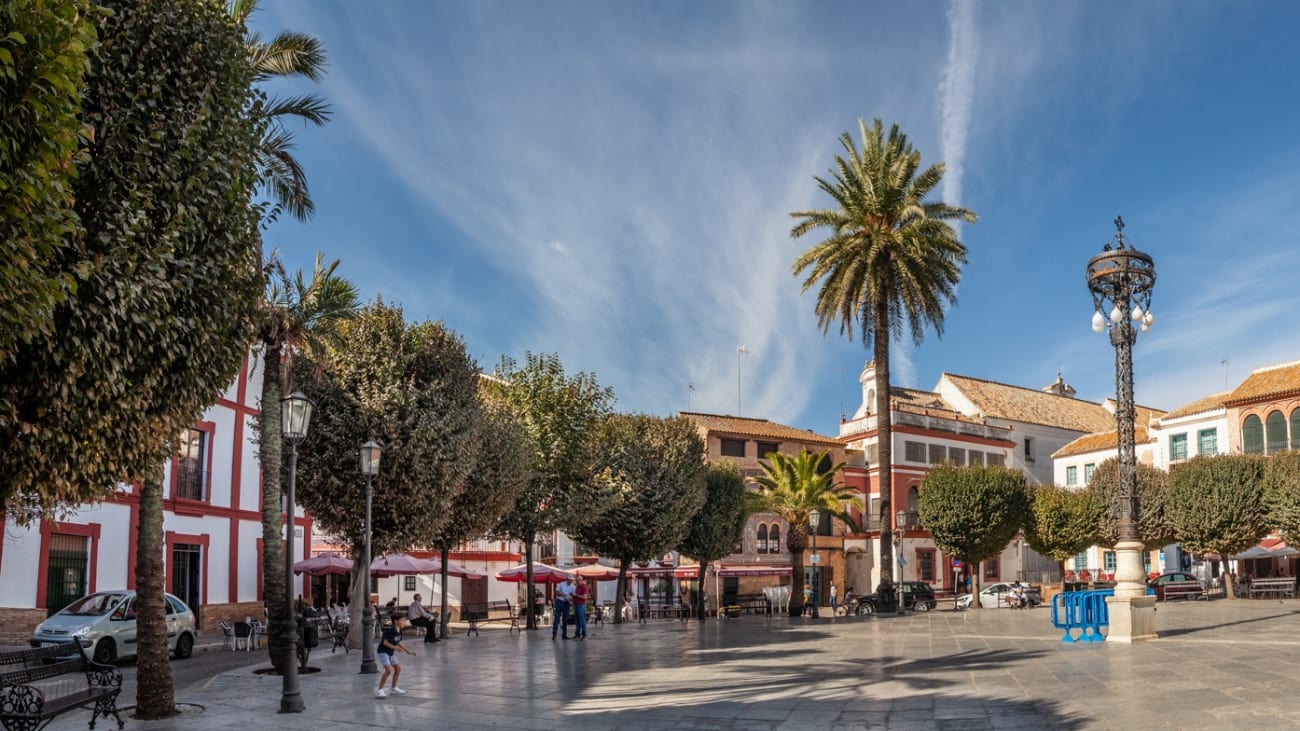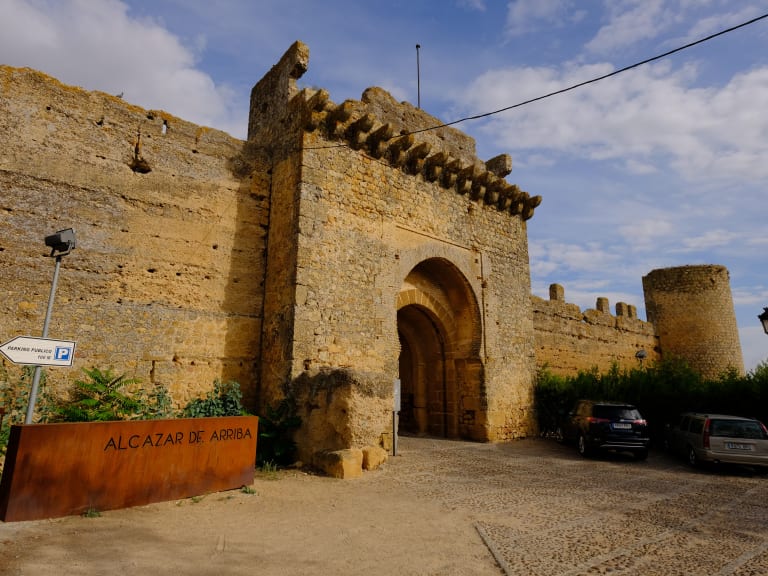10 Things to Do in Carmona
Visit Carmona, a city full of history and corners to discover, located on top of a hill and in a privileged place surrounded by incredible places.

Plaza de San Fernando Carmona | ©Paul VanDerWerf
If you are wondering what to see and do in Seville, you should know that just 30 km from this city is Carmona, a city with more than 5000 years of history where the vestiges of the Phoenician, Roman and Muslim civilizations form an important part of its identity. The Lucero de Europa, as it is often called, gives us an idea of what the layout of the Roman cities was like with their gates, walls, fortresses and squares.
But not everything is history in Carmona, as it is undoubtedly one of the most beautiful villages of Seville, with its narrow streets and low houses, with the beautiful valley that surrounds it and the views that make it simply unforgettable for all its visitors.
1. Visit the Alcazar de la Puerta de Sevilla or Alcazar de Abajo

In the city of Carmona are preserved two fortresses or fortresses, one located in the lower part of the city and one in the upper part, so they are known as the fortress above and the fortress below. Both were part of the ancient walls that surrounded the city, which, in their time, made Carmona one of the safest places against invaders.
The origins of the Alcazar de Abajo date back to 206-237 BC, when the Carthaginians built its first layout, which was reformed by the Romans in the time of Augustus, and by the Muslims during the twelfth and fourteenth centuries.
In addition to learning more about the history of this fortress, its terraces and the Torre de Oro (Golden Tower) will offer you beautiful views of the city.
Useful information
You can visit the interior of the Alcázar de la Puerta de Sevilla for a minimal cost, and one day a week free of charge.
- Hours: Monday to Saturday from 10 am to 6 pm. Sundays and holidays from 10 am to 3 pm.
- Price: Around 2 EUR. Mondays free. Tickets can be purchased at the access area to the Alcazar, which is the tourist office.
- Location: Pl. Blas Infante, 41410 Carmona, Seville
2. Soak up history in the Archaeological Ensemble of Carmona

The Archaeological Ensemble of Carmona includes two Roman buildings dating from the 1st and 2nd centuries AD: the Necropolis and the Amphitheater. Both are located on the outskirts of the city and cover about 8 hectares.
Admission is free for EU citizens and has a minimal cost for other visitors from around the world. My recommendation is that you take a guided tour, because you will learn in detail the interesting history behind these buildings.
The Roman Necropolis of Carmona
The Necropolis is one of the largest Roman funerary spaces preserved. In this place you can see subway burial chambers, crematoria and a museum where you can find a lot of information about how the Roman funeral rituals were, see funerary paintings and learn about other customs.
Of great interest are the collective mausoleum, the tomb of the Elephant (which was also a sanctuary where the god Attis and the goddess Cybele were worshipped) and the tomb of Seville, which houses wall paintings and sculptures.
The Roman Amphitheater
In the Amphitheater in ancient times gladiatorial games and other spectacles were held, i.e., its function was not very different from that of amphitheaters today.
However, the Roman Amphitheater was also linked to the Necropolis, and was even a place where cremations took place. Today the Amphitheater is closed to the public, but can be seen from the outside.
Useful information
- Location: Av. Jorge Bonsor, 9, 41410 Carmona, Seville.
- Hours: Monday closed. Tuesday to Friday from 9 am to 7 pm. Sunday and holidays from 9 am to 3 pm.
- Price: Between 1 and 2 EUR. Free for EU citizens. No reservation is needed.
3. Marvel as you pass through the Cordoba Gate

The Cordoba Gate dates back to the 1st century A.D. and, besides having a defensive function, it served the purpose of demonstrating the great Roman power.
It is truly an imposing building with its vaulted central gate, columns and octagonal towers on the sides. Entering through the Cordoba Gate and finding a narrow street framed by low white houses is truly an unforgettable postcard.
The Cordoba Gate was connected to the Via Augusta, one of the main communication routes of the time. It originally had three gates, two of which were pedestrian and a central one that was dedicated to the passage of carriages. It was also higher, but successive earthquakes caused irreparable damage and much of the building was rebuilt.
Today you can enter the monument and sign up for a free guided tour with prior reservation. Something curious that you can visit in its facilities is the Sunflower Interpretation Center, where information about this plant is provided.
Sunflower Interpretation Center
La Puerta de Córdoba is an excellent viewpoint of the surrounding sunflower fields. Carmona has some 30,000 hectares cultivated with this plant, which is especially popular with the Japanese, who visit Carmona at the time when they bloom, in late spring and early summer.
The Sunflower Interpretation Center exhibits photographs, which in some way try to evoke the sunflower fields in the months when they are not in bloom.
Useful information
- Location of the Puerta de Córdoba: c/ Dolores Quintanilla s/n
- Hours: Monday to Saturday from 10 am to 6 pm. Sundays and holidays from 10 am to 3 pm.
- Price: Free admission for EU citizens. For the rest, it costs about 2 €.
4. Climb to the Alcazar of King Don Pedro or de Arriba

The Alcazar of King Don Pedro is also called Alcazar de Arriba or Alcazar de la Puerta de Marchena.
It is located in the highest part of the city and its construction is attributed to King Pedro I of Castile, who restored it in the fourteenth century to make it his palace. It is believed to have been built in the 12th century, in Islamic times, where a Roman acropolis was located.
Today the Alcazar is considered an Asset of Cultural Interest of Carmona, although you can not see all the splendor it had in its time, but rather the opposite. However, the Marchena gate and the towers that follow one another along the wall, will leave you amazed. You can climb the Torre Mayor or Torre de la Pólvora, to enjoy beautiful panoramic views of the valley of the Vega.
If during the tour you feel like eating something, you can go to the Parador Nacional de Carmona, which was built where the palace used to be. Much admired for its great beauty, it offers rooms where you can stay, a swimming pool, a restaurant serving typical food, a bar and rooms for events.
useful information
- Location: Calle Los Alcázar, s/n, 41410 Carmona, Sevilla.
- Price: Free
- Schedule: From Friday to Tuesday at 11:00 am, 1:00 pm or 4:00 pm, with previous reservation. Write to their email (turismo@carmona.org) or telephone the tourist office (954190955) to book the visit.
5. Have some tapas in the Market Square

In the historic center of the city is the Carmona Market, which is located in the Plaza de Abastos, where the convent of Santa Catalina de Siena used to be.
This convent, which functioned in the late sixteenth and early seventeenth centuries, was expropriated in 1837. The design we can see today belongs to Ramón del Toro and is of neoclassical style.
The Market consists of a rectangular courtyard surrounded by four galleries framed by semicircular arches supported by columns. In the galleries there are food stalls and bars. There you can sit down for a drink and delicious tapas. The Market also often hosts cultural events of all kinds.
Useful information about the market
- Location: Domínguez de la Haza St.
- Hours: Every day from 7 a.m. to midnight.
6. Visit baroque or neo-gothic style churches

If you like to visit old buildings with history, and see pieces of great artistic value, in your tour of Carmona you can not miss the churches. They are even part of the :free tour offered by the Carmona Tourist Office.
The :Iglesia Prioral de Santa María de Asunción was built on the site of an old Muslim mosque. The Patio de los Naranjos or ablution courtyard is the only one still standing from that period.
The church began to be built in 1424 and its construction continued in successive stages until the 19th century. The architectural style of the temple is neo-Gothic. You can also visit the church of San Pedro, located next to the Puerta de Sevilla.
This church was built in the 15th century and reformed in the 17th century, when it acquired the baroque style that we can see today. It has a beautiful glass baptismal font from 1500, among many other artistic objects.
7. Visit the Town Hall of Carmona

The Town Hall is one of the most interesting buildings you can see in Carmona.
The building belonged to the Jesuit Order and was completed in 1621. It was the site of the San Teodomiro school until the expulsion of the Jesuits during the reign of Carlos III.
History buffs will be pleased to know that the old cloistered courtyard is preserved in the town hall, where you can see a mosaic that belonged to a Roman baths of the second century. The mosaic is called none other than the Mosaic of Medusa. There is also a cypus of Tullius Amelius (2nd century) in the meeting room.
Useful information
- Location: C. el Salvador, 2, 41410 Carmona, Seville.
- Hours: Monday from 9 a.m. to 2 p.m. Tuesday to Friday from 8 to 14 hs. Tuesday and Thursday from 16.30 to 18.30 hs. Saturdays and Sundays closed.
8. Discover the Museum of Carmona

In addition to all the collections that you can see in the Museum of Carmona, the building in which it is located is one of the many palace-houses that you can see in Carmona, and is considered an Asset of Cultural Interest.
Its construction dates from the sixteenth century and belonged to the Marquis de las Torres. If you want to know the history of the city, its museum is the right place.
In the Museum of Carmona you will find a collection of pieces ranging from the Paleolithic to the present, through the periods of the Tartessian Carmona, Turdetana, Roman, Islamic and medieval. You can even see a model of what the Roman Carmo was like.
To liven up the tour, you can visit the tapas bar inside the museum.
Useful information
- Location: C. San Ildefonso, 1, 41410 Carmona, Seville.
- Hours: Tuesday to Sunday from 11 am to 7 pm. Monday from 11 a.m. to 2 p.m. From June to August it opens with the summer schedule, Monday to Friday from 10 am to 2 pm and from 6.30 pm to 8.30 pm and Saturdays and Sundays from 9.30 am to 2 pm.
- Price: Around 3 EUR. Tuesdays free.
9. Get to know an old distillery: Puerto de Indias

The old anise factory "Los Hermanos", whose origins date back to 1880, is where the Puerto de Indias distillery operates today. It was bought, by chance, by two brothers, the Rodriguez, who learned the trade from the former owners.
The distillery still uses traditional techniques to make the drinks, such as the copper stills of the old factory.
A curiosity is that the first strawberry gin, which today is consumed all over the world, was made at the distillery. The distillery is also a site that harbors history, as it is fed by subway water springs that were used during Roman times.
It is located on a 7-hectare estate, in a place where Roman baths once operated, the remains of which can still be seen.
The distillery offers guided tours with prior reservation, including tastings. On their website you can find all the information you need to sign up.
10. Walk through the outskirts towards La Batida Cave.

For those who like to walk, you can take a tour around the outskirts of Carmona to visit the caves of La Batida, located about 4 km from the city.
During Roman times, stone was extracted from these caves to be used in constructions, and they were still being extracted in the 15th century. It also functioned as a Muslim prayer space, when it was forbidden to profess that religion in the town.
You can start the walk from the door of Cordoba, following the ancient Via Augusta. On the way you will see the Roman Bridge of the five eyes and the hermitage of San Mateo, Mudejar style.
The caves are in a beautiful natural environment, where you can see native species such as the eagle owl.
This route through the outskirts is usually called environmental route and is ideal for when temperatures are not so high. In any case, a hat to protect you from the sun is never a bad idea.
